FIN200 Assignment: A Detailed Analysis of the Global Financial Crisis
VerifiedAdded on 2023/04/23
|13
|2998
|187
Essay
AI Summary
This essay provides a detailed analysis of the Global Financial Crisis (GFC), exploring its origins in the subprime mortgage crisis and other contributing factors such as global trade imbalances and monetary policy decisions. It discusses the potential for a repeat of the GFC, examining current economic vulnerabilities. The essay further evaluates the scale and impact of the crisis on various countries, highlighting the reforms implemented and proposed, including stimulus packages, rescue plans, and monetary policy changes. It concludes by emphasizing the need for proactive measures to prevent future financial crises. Desklib provides access to this and other solved assignments to aid students in their studies.
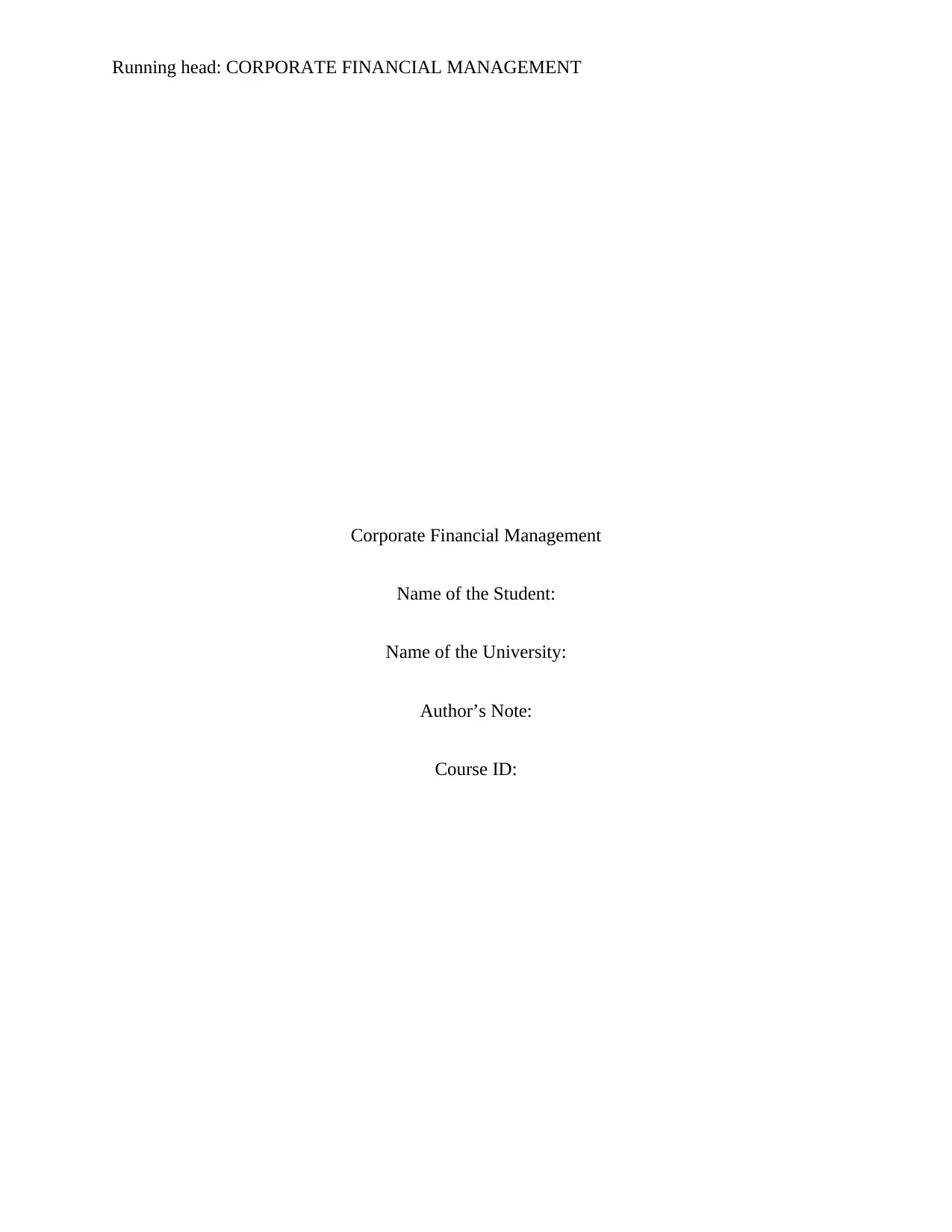
Running head: CORPORATE FINANCIAL MANAGEMENT
Corporate Financial Management
Name of the Student:
Name of the University:
Author’s Note:
Course ID:
Corporate Financial Management
Name of the Student:
Name of the University:
Author’s Note:
Course ID:
Paraphrase This Document
Need a fresh take? Get an instant paraphrase of this document with our AI Paraphraser
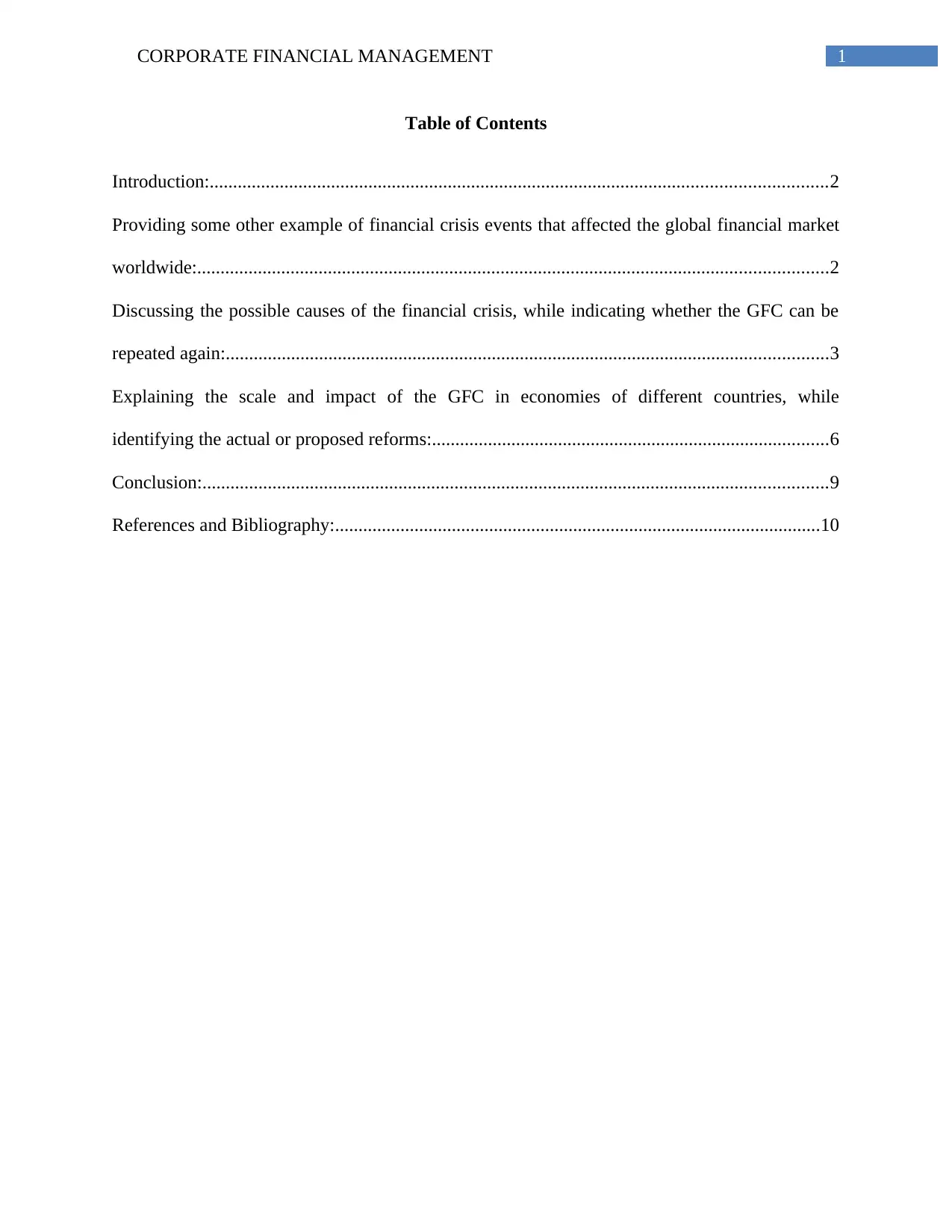
1CORPORATE FINANCIAL MANAGEMENT
Table of Contents
Introduction:....................................................................................................................................2
Providing some other example of financial crisis events that affected the global financial market
worldwide:.......................................................................................................................................2
Discussing the possible causes of the financial crisis, while indicating whether the GFC can be
repeated again:.................................................................................................................................3
Explaining the scale and impact of the GFC in economies of different countries, while
identifying the actual or proposed reforms:.....................................................................................6
Conclusion:......................................................................................................................................9
References and Bibliography:........................................................................................................10
Table of Contents
Introduction:....................................................................................................................................2
Providing some other example of financial crisis events that affected the global financial market
worldwide:.......................................................................................................................................2
Discussing the possible causes of the financial crisis, while indicating whether the GFC can be
repeated again:.................................................................................................................................3
Explaining the scale and impact of the GFC in economies of different countries, while
identifying the actual or proposed reforms:.....................................................................................6
Conclusion:......................................................................................................................................9
References and Bibliography:........................................................................................................10
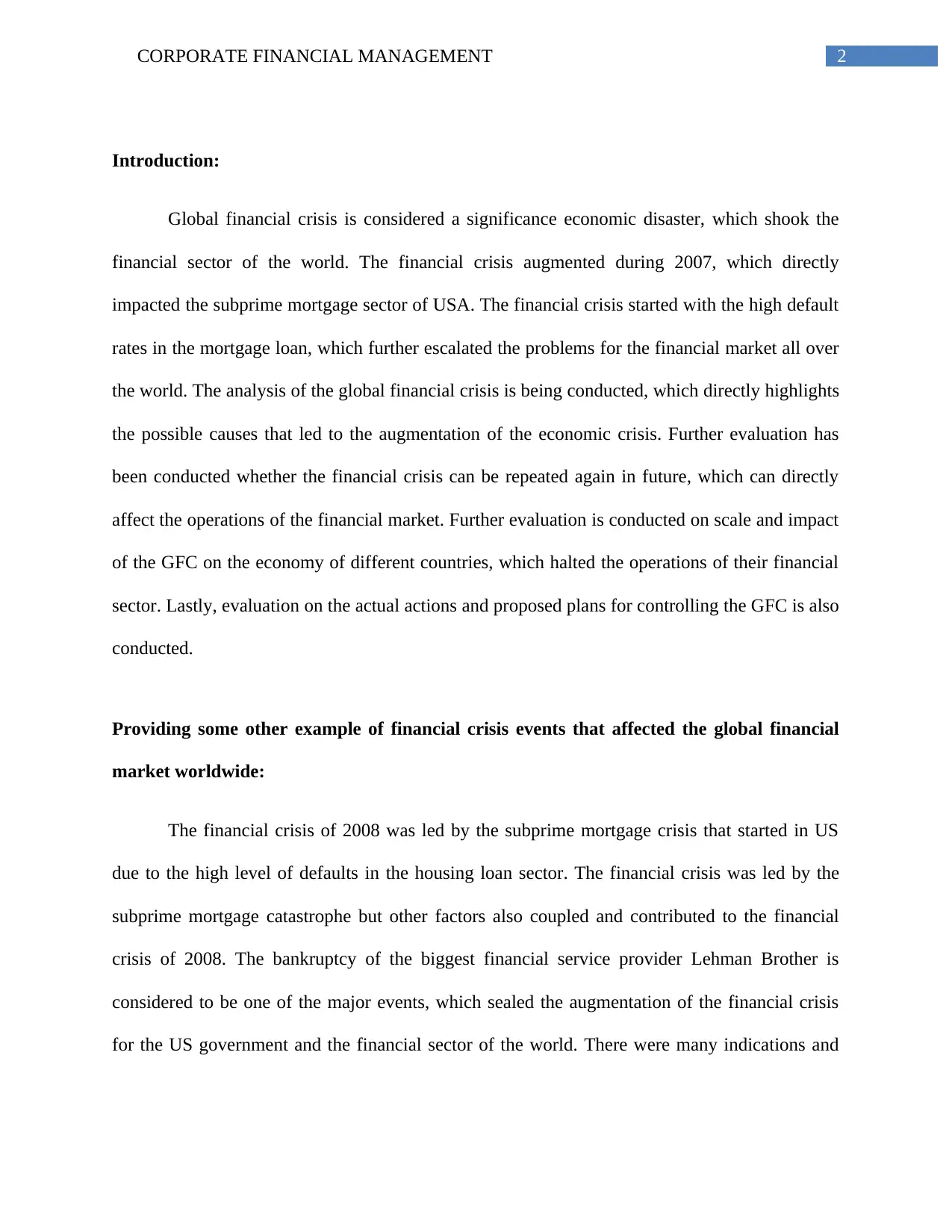
2CORPORATE FINANCIAL MANAGEMENT
Introduction:
Global financial crisis is considered a significance economic disaster, which shook the
financial sector of the world. The financial crisis augmented during 2007, which directly
impacted the subprime mortgage sector of USA. The financial crisis started with the high default
rates in the mortgage loan, which further escalated the problems for the financial market all over
the world. The analysis of the global financial crisis is being conducted, which directly highlights
the possible causes that led to the augmentation of the economic crisis. Further evaluation has
been conducted whether the financial crisis can be repeated again in future, which can directly
affect the operations of the financial market. Further evaluation is conducted on scale and impact
of the GFC on the economy of different countries, which halted the operations of their financial
sector. Lastly, evaluation on the actual actions and proposed plans for controlling the GFC is also
conducted.
Providing some other example of financial crisis events that affected the global financial
market worldwide:
The financial crisis of 2008 was led by the subprime mortgage crisis that started in US
due to the high level of defaults in the housing loan sector. The financial crisis was led by the
subprime mortgage catastrophe but other factors also coupled and contributed to the financial
crisis of 2008. The bankruptcy of the biggest financial service provider Lehman Brother is
considered to be one of the major events, which sealed the augmentation of the financial crisis
for the US government and the financial sector of the world. There were many indications and
Introduction:
Global financial crisis is considered a significance economic disaster, which shook the
financial sector of the world. The financial crisis augmented during 2007, which directly
impacted the subprime mortgage sector of USA. The financial crisis started with the high default
rates in the mortgage loan, which further escalated the problems for the financial market all over
the world. The analysis of the global financial crisis is being conducted, which directly highlights
the possible causes that led to the augmentation of the economic crisis. Further evaluation has
been conducted whether the financial crisis can be repeated again in future, which can directly
affect the operations of the financial market. Further evaluation is conducted on scale and impact
of the GFC on the economy of different countries, which halted the operations of their financial
sector. Lastly, evaluation on the actual actions and proposed plans for controlling the GFC is also
conducted.
Providing some other example of financial crisis events that affected the global financial
market worldwide:
The financial crisis of 2008 was led by the subprime mortgage crisis that started in US
due to the high level of defaults in the housing loan sector. The financial crisis was led by the
subprime mortgage catastrophe but other factors also coupled and contributed to the financial
crisis of 2008. The bankruptcy of the biggest financial service provider Lehman Brother is
considered to be one of the major events, which sealed the augmentation of the financial crisis
for the US government and the financial sector of the world. There were many indications and
⊘ This is a preview!⊘
Do you want full access?
Subscribe today to unlock all pages.

Trusted by 1+ million students worldwide
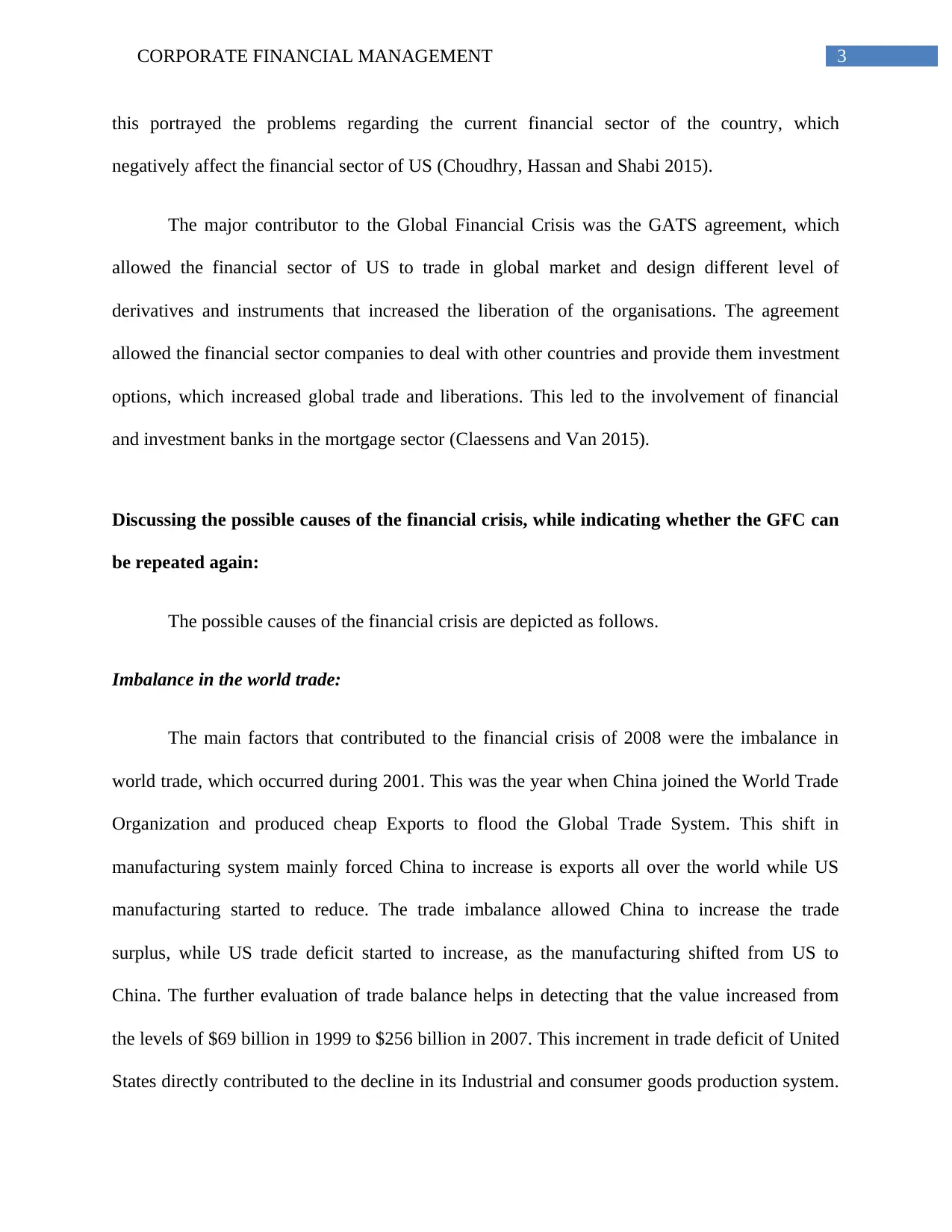
3CORPORATE FINANCIAL MANAGEMENT
this portrayed the problems regarding the current financial sector of the country, which
negatively affect the financial sector of US (Choudhry, Hassan and Shabi 2015).
The major contributor to the Global Financial Crisis was the GATS agreement, which
allowed the financial sector of US to trade in global market and design different level of
derivatives and instruments that increased the liberation of the organisations. The agreement
allowed the financial sector companies to deal with other countries and provide them investment
options, which increased global trade and liberations. This led to the involvement of financial
and investment banks in the mortgage sector (Claessens and Van 2015).
Discussing the possible causes of the financial crisis, while indicating whether the GFC can
be repeated again:
The possible causes of the financial crisis are depicted as follows.
Imbalance in the world trade:
The main factors that contributed to the financial crisis of 2008 were the imbalance in
world trade, which occurred during 2001. This was the year when China joined the World Trade
Organization and produced cheap Exports to flood the Global Trade System. This shift in
manufacturing system mainly forced China to increase is exports all over the world while US
manufacturing started to reduce. The trade imbalance allowed China to increase the trade
surplus, while US trade deficit started to increase, as the manufacturing shifted from US to
China. The further evaluation of trade balance helps in detecting that the value increased from
the levels of $69 billion in 1999 to $256 billion in 2007. This increment in trade deficit of United
States directly contributed to the decline in its Industrial and consumer goods production system.
this portrayed the problems regarding the current financial sector of the country, which
negatively affect the financial sector of US (Choudhry, Hassan and Shabi 2015).
The major contributor to the Global Financial Crisis was the GATS agreement, which
allowed the financial sector of US to trade in global market and design different level of
derivatives and instruments that increased the liberation of the organisations. The agreement
allowed the financial sector companies to deal with other countries and provide them investment
options, which increased global trade and liberations. This led to the involvement of financial
and investment banks in the mortgage sector (Claessens and Van 2015).
Discussing the possible causes of the financial crisis, while indicating whether the GFC can
be repeated again:
The possible causes of the financial crisis are depicted as follows.
Imbalance in the world trade:
The main factors that contributed to the financial crisis of 2008 were the imbalance in
world trade, which occurred during 2001. This was the year when China joined the World Trade
Organization and produced cheap Exports to flood the Global Trade System. This shift in
manufacturing system mainly forced China to increase is exports all over the world while US
manufacturing started to reduce. The trade imbalance allowed China to increase the trade
surplus, while US trade deficit started to increase, as the manufacturing shifted from US to
China. The further evaluation of trade balance helps in detecting that the value increased from
the levels of $69 billion in 1999 to $256 billion in 2007. This increment in trade deficit of United
States directly contributed to the decline in its Industrial and consumer goods production system.
Paraphrase This Document
Need a fresh take? Get an instant paraphrase of this document with our AI Paraphraser
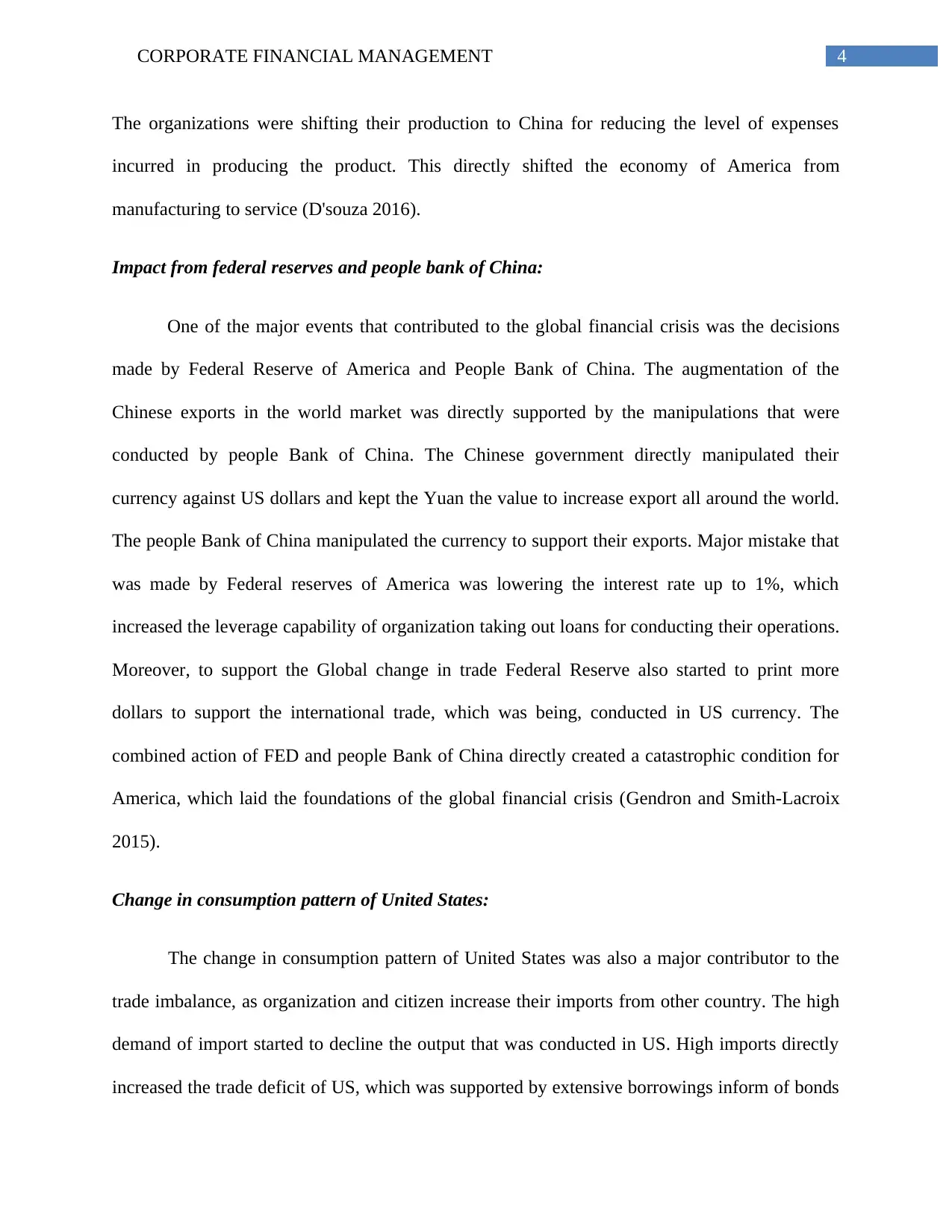
4CORPORATE FINANCIAL MANAGEMENT
The organizations were shifting their production to China for reducing the level of expenses
incurred in producing the product. This directly shifted the economy of America from
manufacturing to service (D'souza 2016).
Impact from federal reserves and people bank of China:
One of the major events that contributed to the global financial crisis was the decisions
made by Federal Reserve of America and People Bank of China. The augmentation of the
Chinese exports in the world market was directly supported by the manipulations that were
conducted by people Bank of China. The Chinese government directly manipulated their
currency against US dollars and kept the Yuan the value to increase export all around the world.
The people Bank of China manipulated the currency to support their exports. Major mistake that
was made by Federal reserves of America was lowering the interest rate up to 1%, which
increased the leverage capability of organization taking out loans for conducting their operations.
Moreover, to support the Global change in trade Federal Reserve also started to print more
dollars to support the international trade, which was being, conducted in US currency. The
combined action of FED and people Bank of China directly created a catastrophic condition for
America, which laid the foundations of the global financial crisis (Gendron and Smith-Lacroix
2015).
Change in consumption pattern of United States:
The change in consumption pattern of United States was also a major contributor to the
trade imbalance, as organization and citizen increase their imports from other country. The high
demand of import started to decline the output that was conducted in US. High imports directly
increased the trade deficit of US, which was supported by extensive borrowings inform of bonds
The organizations were shifting their production to China for reducing the level of expenses
incurred in producing the product. This directly shifted the economy of America from
manufacturing to service (D'souza 2016).
Impact from federal reserves and people bank of China:
One of the major events that contributed to the global financial crisis was the decisions
made by Federal Reserve of America and People Bank of China. The augmentation of the
Chinese exports in the world market was directly supported by the manipulations that were
conducted by people Bank of China. The Chinese government directly manipulated their
currency against US dollars and kept the Yuan the value to increase export all around the world.
The people Bank of China manipulated the currency to support their exports. Major mistake that
was made by Federal reserves of America was lowering the interest rate up to 1%, which
increased the leverage capability of organization taking out loans for conducting their operations.
Moreover, to support the Global change in trade Federal Reserve also started to print more
dollars to support the international trade, which was being, conducted in US currency. The
combined action of FED and people Bank of China directly created a catastrophic condition for
America, which laid the foundations of the global financial crisis (Gendron and Smith-Lacroix
2015).
Change in consumption pattern of United States:
The change in consumption pattern of United States was also a major contributor to the
trade imbalance, as organization and citizen increase their imports from other country. The high
demand of import started to decline the output that was conducted in US. High imports directly
increased the trade deficit of US, which was supported by extensive borrowings inform of bonds
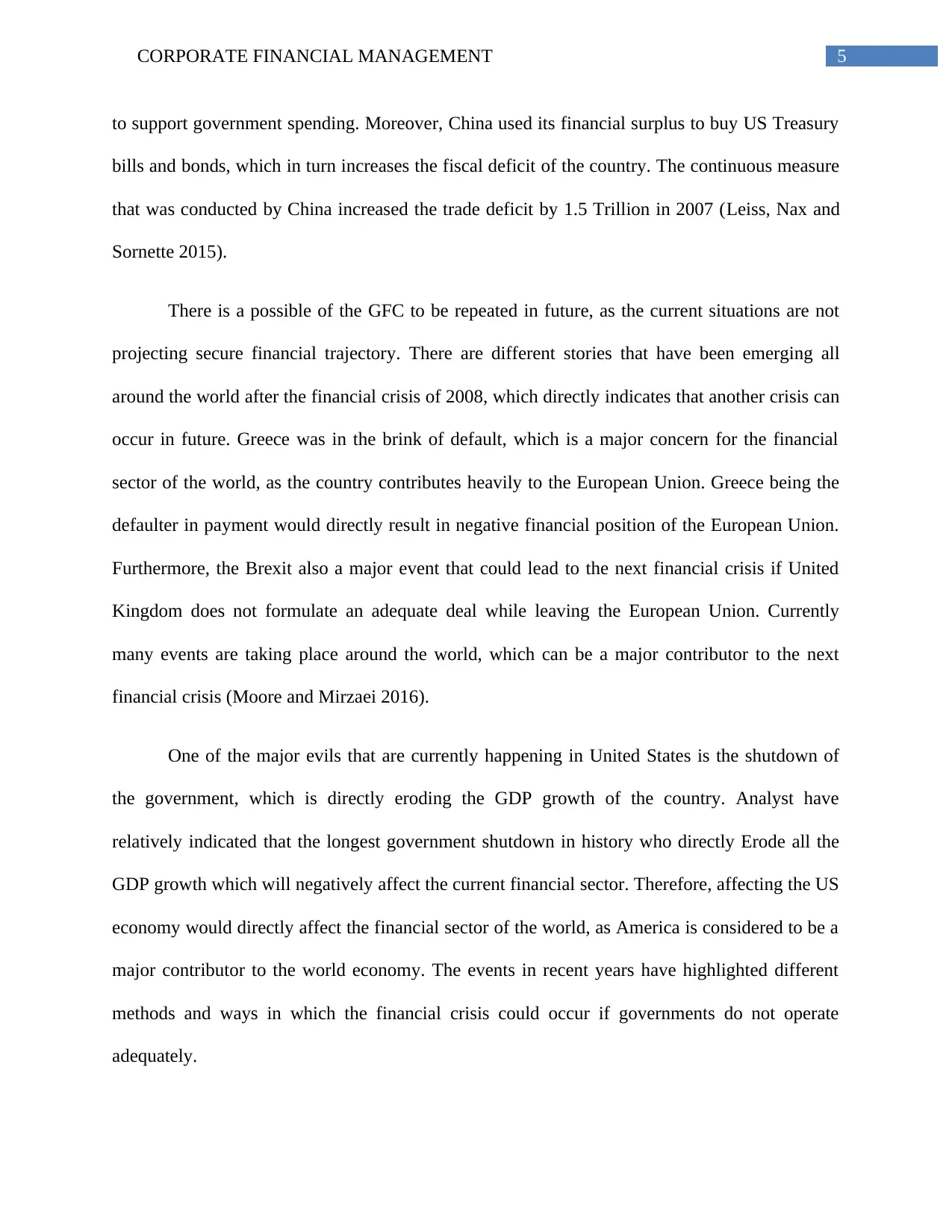
5CORPORATE FINANCIAL MANAGEMENT
to support government spending. Moreover, China used its financial surplus to buy US Treasury
bills and bonds, which in turn increases the fiscal deficit of the country. The continuous measure
that was conducted by China increased the trade deficit by 1.5 Trillion in 2007 (Leiss, Nax and
Sornette 2015).
There is a possible of the GFC to be repeated in future, as the current situations are not
projecting secure financial trajectory. There are different stories that have been emerging all
around the world after the financial crisis of 2008, which directly indicates that another crisis can
occur in future. Greece was in the brink of default, which is a major concern for the financial
sector of the world, as the country contributes heavily to the European Union. Greece being the
defaulter in payment would directly result in negative financial position of the European Union.
Furthermore, the Brexit also a major event that could lead to the next financial crisis if United
Kingdom does not formulate an adequate deal while leaving the European Union. Currently
many events are taking place around the world, which can be a major contributor to the next
financial crisis (Moore and Mirzaei 2016).
One of the major evils that are currently happening in United States is the shutdown of
the government, which is directly eroding the GDP growth of the country. Analyst have
relatively indicated that the longest government shutdown in history who directly Erode all the
GDP growth which will negatively affect the current financial sector. Therefore, affecting the US
economy would directly affect the financial sector of the world, as America is considered to be a
major contributor to the world economy. The events in recent years have highlighted different
methods and ways in which the financial crisis could occur if governments do not operate
adequately.
to support government spending. Moreover, China used its financial surplus to buy US Treasury
bills and bonds, which in turn increases the fiscal deficit of the country. The continuous measure
that was conducted by China increased the trade deficit by 1.5 Trillion in 2007 (Leiss, Nax and
Sornette 2015).
There is a possible of the GFC to be repeated in future, as the current situations are not
projecting secure financial trajectory. There are different stories that have been emerging all
around the world after the financial crisis of 2008, which directly indicates that another crisis can
occur in future. Greece was in the brink of default, which is a major concern for the financial
sector of the world, as the country contributes heavily to the European Union. Greece being the
defaulter in payment would directly result in negative financial position of the European Union.
Furthermore, the Brexit also a major event that could lead to the next financial crisis if United
Kingdom does not formulate an adequate deal while leaving the European Union. Currently
many events are taking place around the world, which can be a major contributor to the next
financial crisis (Moore and Mirzaei 2016).
One of the major evils that are currently happening in United States is the shutdown of
the government, which is directly eroding the GDP growth of the country. Analyst have
relatively indicated that the longest government shutdown in history who directly Erode all the
GDP growth which will negatively affect the current financial sector. Therefore, affecting the US
economy would directly affect the financial sector of the world, as America is considered to be a
major contributor to the world economy. The events in recent years have highlighted different
methods and ways in which the financial crisis could occur if governments do not operate
adequately.
⊘ This is a preview!⊘
Do you want full access?
Subscribe today to unlock all pages.

Trusted by 1+ million students worldwide
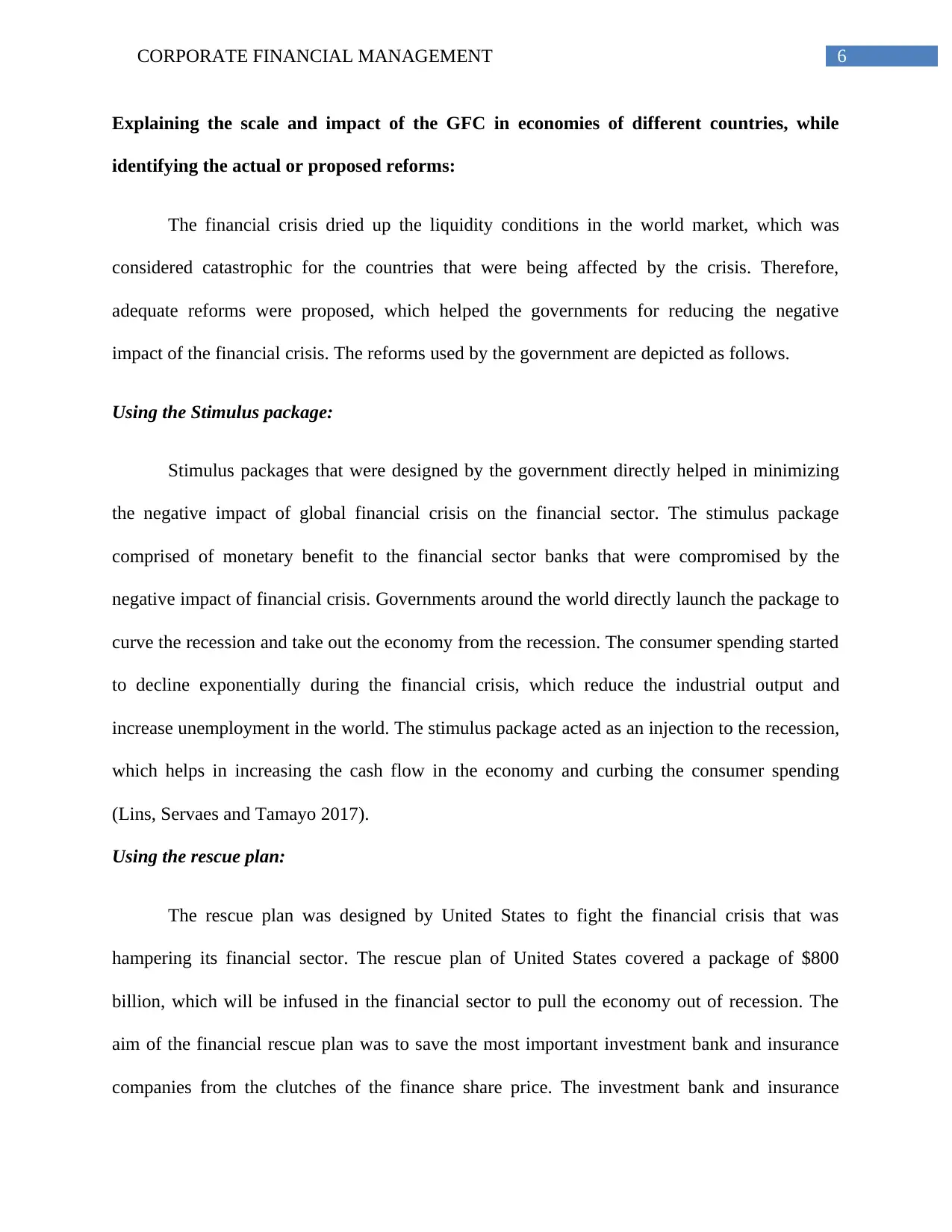
6CORPORATE FINANCIAL MANAGEMENT
Explaining the scale and impact of the GFC in economies of different countries, while
identifying the actual or proposed reforms:
The financial crisis dried up the liquidity conditions in the world market, which was
considered catastrophic for the countries that were being affected by the crisis. Therefore,
adequate reforms were proposed, which helped the governments for reducing the negative
impact of the financial crisis. The reforms used by the government are depicted as follows.
Using the Stimulus package:
Stimulus packages that were designed by the government directly helped in minimizing
the negative impact of global financial crisis on the financial sector. The stimulus package
comprised of monetary benefit to the financial sector banks that were compromised by the
negative impact of financial crisis. Governments around the world directly launch the package to
curve the recession and take out the economy from the recession. The consumer spending started
to decline exponentially during the financial crisis, which reduce the industrial output and
increase unemployment in the world. The stimulus package acted as an injection to the recession,
which helps in increasing the cash flow in the economy and curbing the consumer spending
(Lins, Servaes and Tamayo 2017).
Using the rescue plan:
The rescue plan was designed by United States to fight the financial crisis that was
hampering its financial sector. The rescue plan of United States covered a package of $800
billion, which will be infused in the financial sector to pull the economy out of recession. The
aim of the financial rescue plan was to save the most important investment bank and insurance
companies from the clutches of the finance share price. The investment bank and insurance
Explaining the scale and impact of the GFC in economies of different countries, while
identifying the actual or proposed reforms:
The financial crisis dried up the liquidity conditions in the world market, which was
considered catastrophic for the countries that were being affected by the crisis. Therefore,
adequate reforms were proposed, which helped the governments for reducing the negative
impact of the financial crisis. The reforms used by the government are depicted as follows.
Using the Stimulus package:
Stimulus packages that were designed by the government directly helped in minimizing
the negative impact of global financial crisis on the financial sector. The stimulus package
comprised of monetary benefit to the financial sector banks that were compromised by the
negative impact of financial crisis. Governments around the world directly launch the package to
curve the recession and take out the economy from the recession. The consumer spending started
to decline exponentially during the financial crisis, which reduce the industrial output and
increase unemployment in the world. The stimulus package acted as an injection to the recession,
which helps in increasing the cash flow in the economy and curbing the consumer spending
(Lins, Servaes and Tamayo 2017).
Using the rescue plan:
The rescue plan was designed by United States to fight the financial crisis that was
hampering its financial sector. The rescue plan of United States covered a package of $800
billion, which will be infused in the financial sector to pull the economy out of recession. The
aim of the financial rescue plan was to save the most important investment bank and insurance
companies from the clutches of the finance share price. The investment bank and insurance
Paraphrase This Document
Need a fresh take? Get an instant paraphrase of this document with our AI Paraphraser
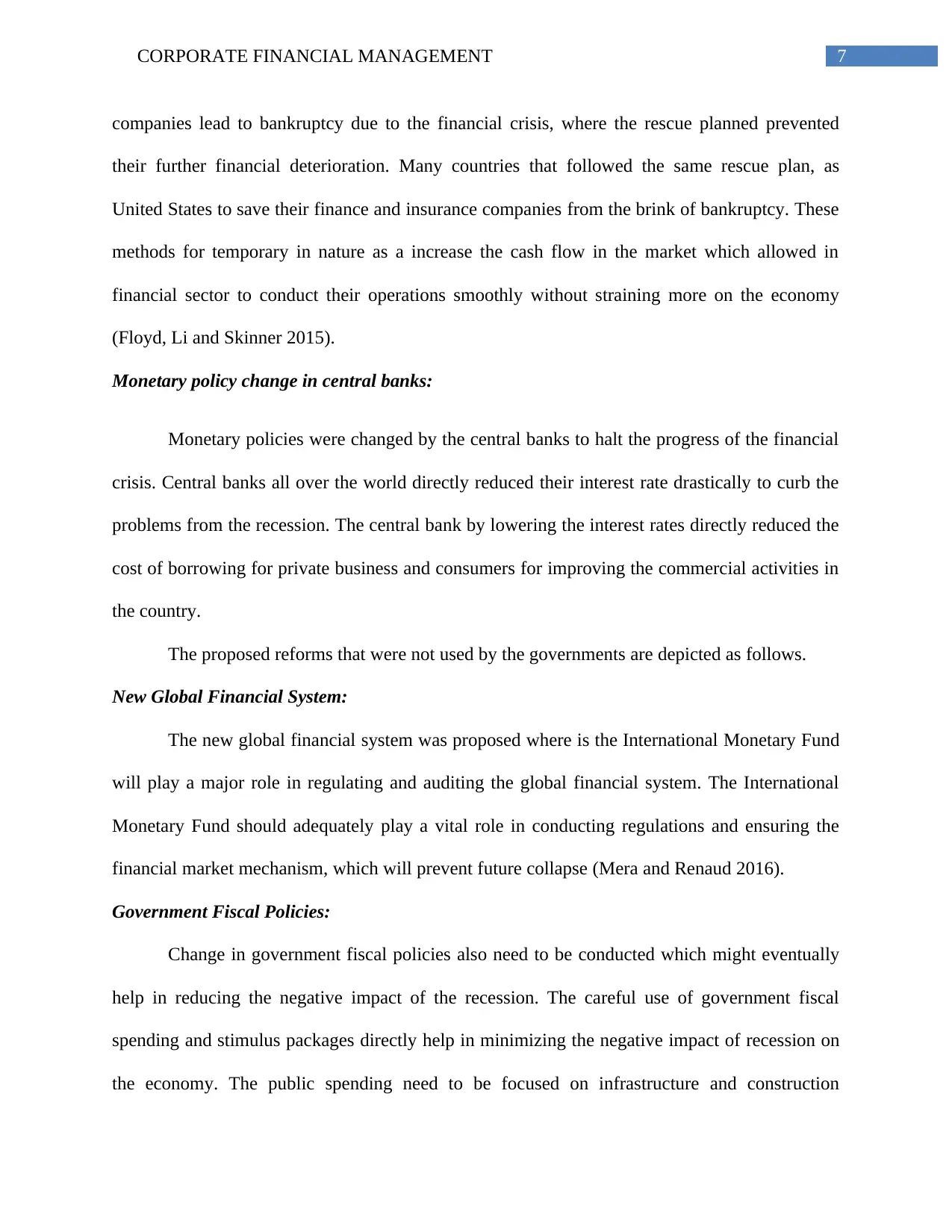
7CORPORATE FINANCIAL MANAGEMENT
companies lead to bankruptcy due to the financial crisis, where the rescue planned prevented
their further financial deterioration. Many countries that followed the same rescue plan, as
United States to save their finance and insurance companies from the brink of bankruptcy. These
methods for temporary in nature as a increase the cash flow in the market which allowed in
financial sector to conduct their operations smoothly without straining more on the economy
(Floyd, Li and Skinner 2015).
Monetary policy change in central banks:
Monetary policies were changed by the central banks to halt the progress of the financial
crisis. Central banks all over the world directly reduced their interest rate drastically to curb the
problems from the recession. The central bank by lowering the interest rates directly reduced the
cost of borrowing for private business and consumers for improving the commercial activities in
the country.
The proposed reforms that were not used by the governments are depicted as follows.
New Global Financial System:
The new global financial system was proposed where is the International Monetary Fund
will play a major role in regulating and auditing the global financial system. The International
Monetary Fund should adequately play a vital role in conducting regulations and ensuring the
financial market mechanism, which will prevent future collapse (Mera and Renaud 2016).
Government Fiscal Policies:
Change in government fiscal policies also need to be conducted which might eventually
help in reducing the negative impact of the recession. The careful use of government fiscal
spending and stimulus packages directly help in minimizing the negative impact of recession on
the economy. The public spending need to be focused on infrastructure and construction
companies lead to bankruptcy due to the financial crisis, where the rescue planned prevented
their further financial deterioration. Many countries that followed the same rescue plan, as
United States to save their finance and insurance companies from the brink of bankruptcy. These
methods for temporary in nature as a increase the cash flow in the market which allowed in
financial sector to conduct their operations smoothly without straining more on the economy
(Floyd, Li and Skinner 2015).
Monetary policy change in central banks:
Monetary policies were changed by the central banks to halt the progress of the financial
crisis. Central banks all over the world directly reduced their interest rate drastically to curb the
problems from the recession. The central bank by lowering the interest rates directly reduced the
cost of borrowing for private business and consumers for improving the commercial activities in
the country.
The proposed reforms that were not used by the governments are depicted as follows.
New Global Financial System:
The new global financial system was proposed where is the International Monetary Fund
will play a major role in regulating and auditing the global financial system. The International
Monetary Fund should adequately play a vital role in conducting regulations and ensuring the
financial market mechanism, which will prevent future collapse (Mera and Renaud 2016).
Government Fiscal Policies:
Change in government fiscal policies also need to be conducted which might eventually
help in reducing the negative impact of the recession. The careful use of government fiscal
spending and stimulus packages directly help in minimizing the negative impact of recession on
the economy. The public spending need to be focused on infrastructure and construction
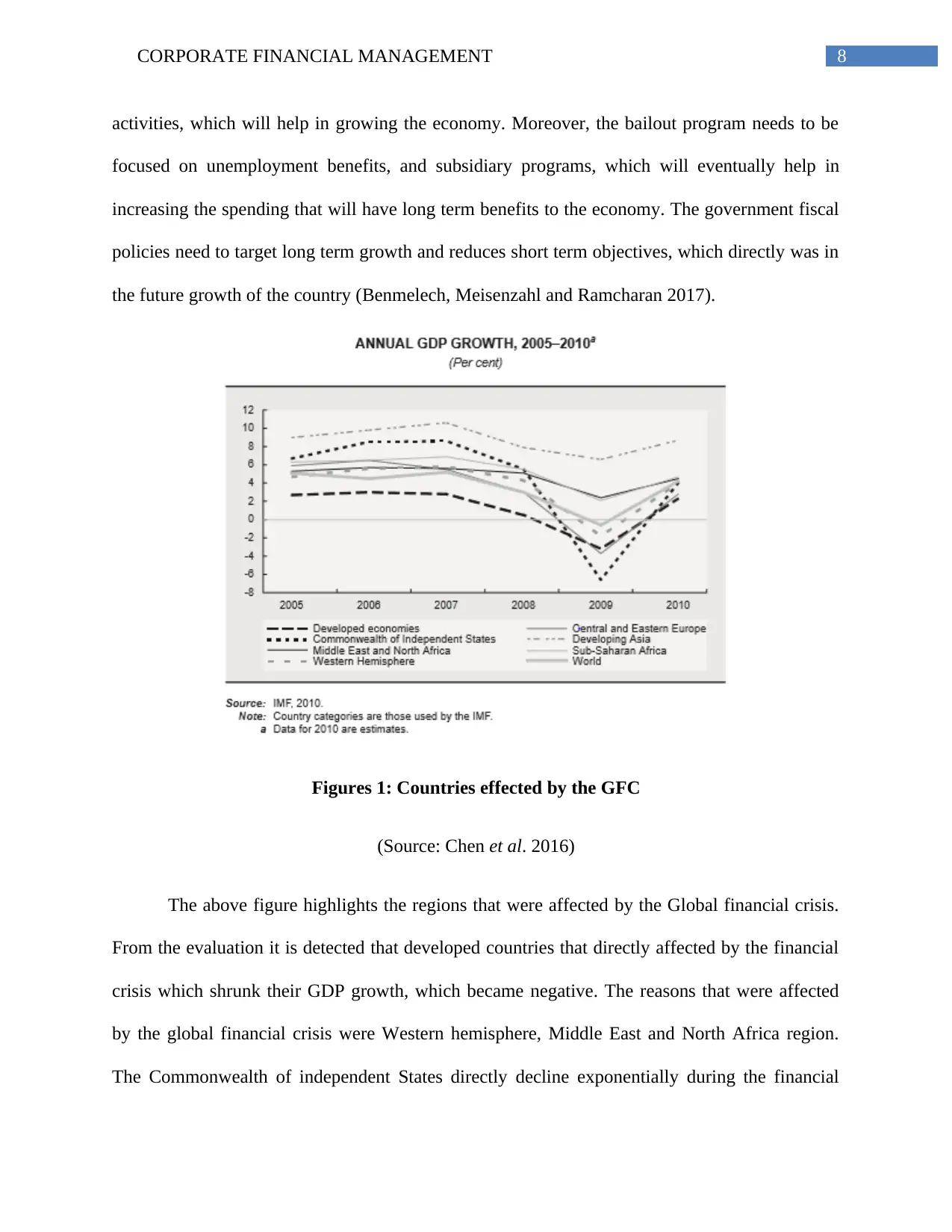
8CORPORATE FINANCIAL MANAGEMENT
activities, which will help in growing the economy. Moreover, the bailout program needs to be
focused on unemployment benefits, and subsidiary programs, which will eventually help in
increasing the spending that will have long term benefits to the economy. The government fiscal
policies need to target long term growth and reduces short term objectives, which directly was in
the future growth of the country (Benmelech, Meisenzahl and Ramcharan 2017).
Figures 1: Countries effected by the GFC
(Source: Chen et al. 2016)
The above figure highlights the regions that were affected by the Global financial crisis.
From the evaluation it is detected that developed countries that directly affected by the financial
crisis which shrunk their GDP growth, which became negative. The reasons that were affected
by the global financial crisis were Western hemisphere, Middle East and North Africa region.
The Commonwealth of independent States directly decline exponentially during the financial
activities, which will help in growing the economy. Moreover, the bailout program needs to be
focused on unemployment benefits, and subsidiary programs, which will eventually help in
increasing the spending that will have long term benefits to the economy. The government fiscal
policies need to target long term growth and reduces short term objectives, which directly was in
the future growth of the country (Benmelech, Meisenzahl and Ramcharan 2017).
Figures 1: Countries effected by the GFC
(Source: Chen et al. 2016)
The above figure highlights the regions that were affected by the Global financial crisis.
From the evaluation it is detected that developed countries that directly affected by the financial
crisis which shrunk their GDP growth, which became negative. The reasons that were affected
by the global financial crisis were Western hemisphere, Middle East and North Africa region.
The Commonwealth of independent States directly decline exponentially during the financial
⊘ This is a preview!⊘
Do you want full access?
Subscribe today to unlock all pages.

Trusted by 1+ million students worldwide
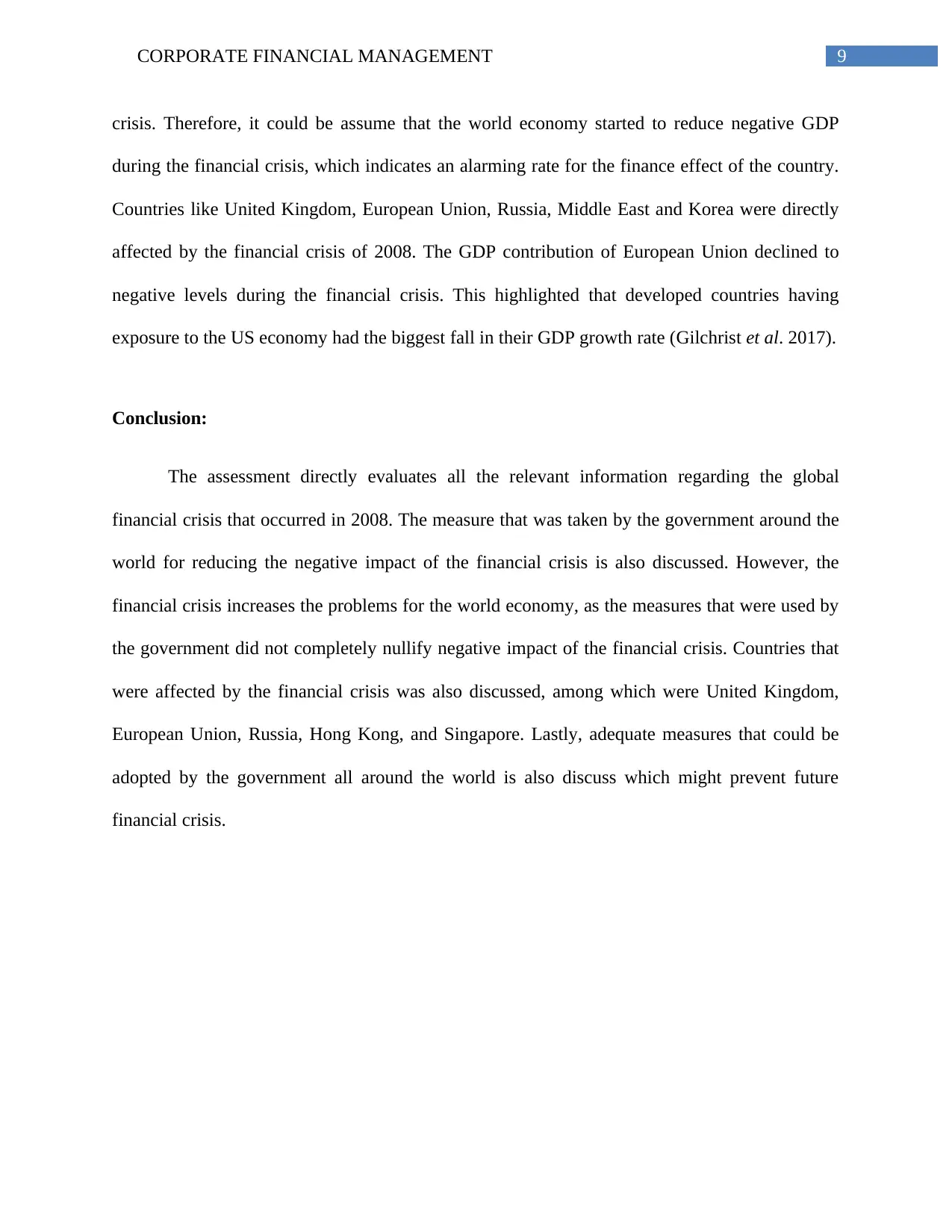
9CORPORATE FINANCIAL MANAGEMENT
crisis. Therefore, it could be assume that the world economy started to reduce negative GDP
during the financial crisis, which indicates an alarming rate for the finance effect of the country.
Countries like United Kingdom, European Union, Russia, Middle East and Korea were directly
affected by the financial crisis of 2008. The GDP contribution of European Union declined to
negative levels during the financial crisis. This highlighted that developed countries having
exposure to the US economy had the biggest fall in their GDP growth rate (Gilchrist et al. 2017).
Conclusion:
The assessment directly evaluates all the relevant information regarding the global
financial crisis that occurred in 2008. The measure that was taken by the government around the
world for reducing the negative impact of the financial crisis is also discussed. However, the
financial crisis increases the problems for the world economy, as the measures that were used by
the government did not completely nullify negative impact of the financial crisis. Countries that
were affected by the financial crisis was also discussed, among which were United Kingdom,
European Union, Russia, Hong Kong, and Singapore. Lastly, adequate measures that could be
adopted by the government all around the world is also discuss which might prevent future
financial crisis.
crisis. Therefore, it could be assume that the world economy started to reduce negative GDP
during the financial crisis, which indicates an alarming rate for the finance effect of the country.
Countries like United Kingdom, European Union, Russia, Middle East and Korea were directly
affected by the financial crisis of 2008. The GDP contribution of European Union declined to
negative levels during the financial crisis. This highlighted that developed countries having
exposure to the US economy had the biggest fall in their GDP growth rate (Gilchrist et al. 2017).
Conclusion:
The assessment directly evaluates all the relevant information regarding the global
financial crisis that occurred in 2008. The measure that was taken by the government around the
world for reducing the negative impact of the financial crisis is also discussed. However, the
financial crisis increases the problems for the world economy, as the measures that were used by
the government did not completely nullify negative impact of the financial crisis. Countries that
were affected by the financial crisis was also discussed, among which were United Kingdom,
European Union, Russia, Hong Kong, and Singapore. Lastly, adequate measures that could be
adopted by the government all around the world is also discuss which might prevent future
financial crisis.
Paraphrase This Document
Need a fresh take? Get an instant paraphrase of this document with our AI Paraphraser
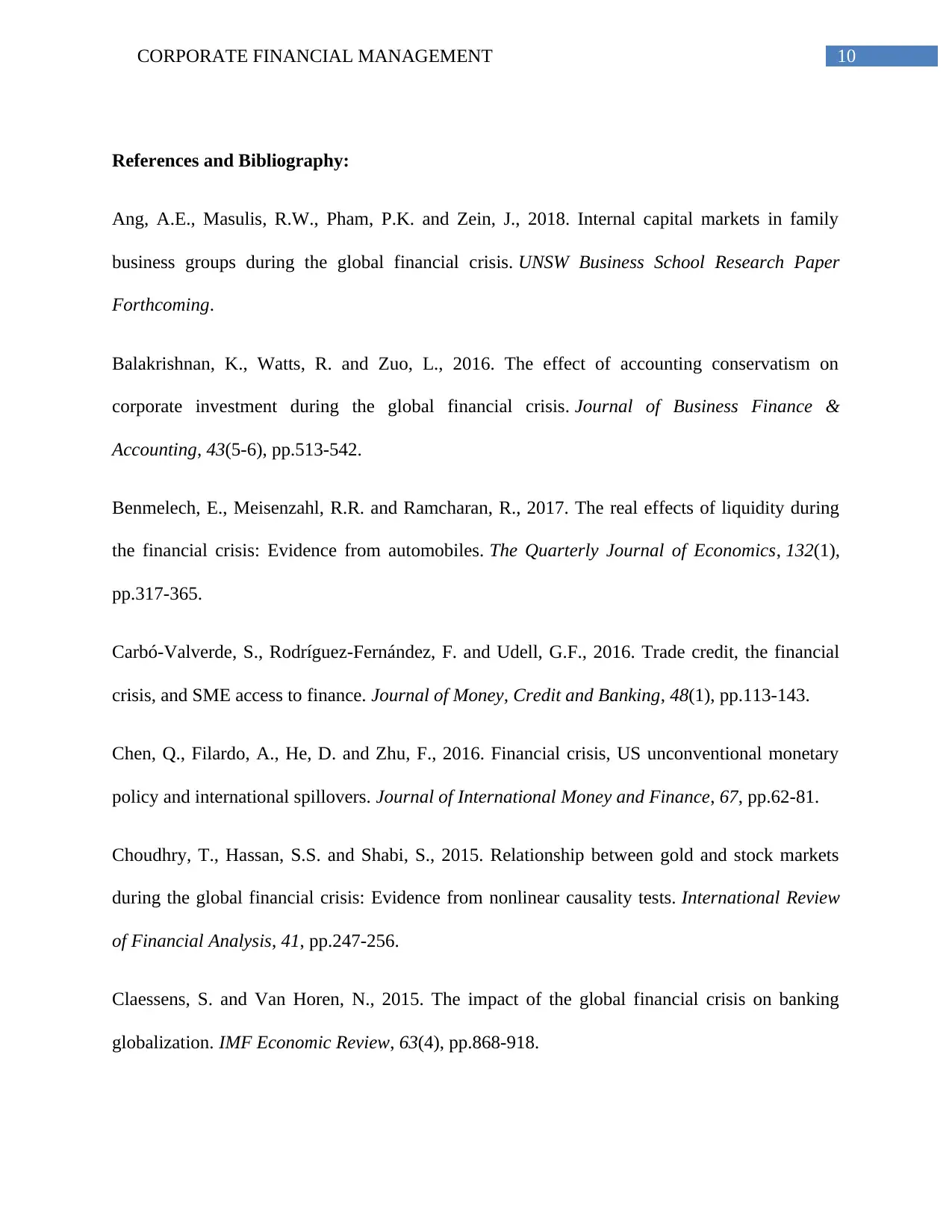
10CORPORATE FINANCIAL MANAGEMENT
References and Bibliography:
Ang, A.E., Masulis, R.W., Pham, P.K. and Zein, J., 2018. Internal capital markets in family
business groups during the global financial crisis. UNSW Business School Research Paper
Forthcoming.
Balakrishnan, K., Watts, R. and Zuo, L., 2016. The effect of accounting conservatism on
corporate investment during the global financial crisis. Journal of Business Finance &
Accounting, 43(5-6), pp.513-542.
Benmelech, E., Meisenzahl, R.R. and Ramcharan, R., 2017. The real effects of liquidity during
the financial crisis: Evidence from automobiles. The Quarterly Journal of Economics, 132(1),
pp.317-365.
Carbó‐Valverde, S., Rodríguez‐Fernández, F. and Udell, G.F., 2016. Trade credit, the financial
crisis, and SME access to finance. Journal of Money, Credit and Banking, 48(1), pp.113-143.
Chen, Q., Filardo, A., He, D. and Zhu, F., 2016. Financial crisis, US unconventional monetary
policy and international spillovers. Journal of International Money and Finance, 67, pp.62-81.
Choudhry, T., Hassan, S.S. and Shabi, S., 2015. Relationship between gold and stock markets
during the global financial crisis: Evidence from nonlinear causality tests. International Review
of Financial Analysis, 41, pp.247-256.
Claessens, S. and Van Horen, N., 2015. The impact of the global financial crisis on banking
globalization. IMF Economic Review, 63(4), pp.868-918.
References and Bibliography:
Ang, A.E., Masulis, R.W., Pham, P.K. and Zein, J., 2018. Internal capital markets in family
business groups during the global financial crisis. UNSW Business School Research Paper
Forthcoming.
Balakrishnan, K., Watts, R. and Zuo, L., 2016. The effect of accounting conservatism on
corporate investment during the global financial crisis. Journal of Business Finance &
Accounting, 43(5-6), pp.513-542.
Benmelech, E., Meisenzahl, R.R. and Ramcharan, R., 2017. The real effects of liquidity during
the financial crisis: Evidence from automobiles. The Quarterly Journal of Economics, 132(1),
pp.317-365.
Carbó‐Valverde, S., Rodríguez‐Fernández, F. and Udell, G.F., 2016. Trade credit, the financial
crisis, and SME access to finance. Journal of Money, Credit and Banking, 48(1), pp.113-143.
Chen, Q., Filardo, A., He, D. and Zhu, F., 2016. Financial crisis, US unconventional monetary
policy and international spillovers. Journal of International Money and Finance, 67, pp.62-81.
Choudhry, T., Hassan, S.S. and Shabi, S., 2015. Relationship between gold and stock markets
during the global financial crisis: Evidence from nonlinear causality tests. International Review
of Financial Analysis, 41, pp.247-256.
Claessens, S. and Van Horen, N., 2015. The impact of the global financial crisis on banking
globalization. IMF Economic Review, 63(4), pp.868-918.
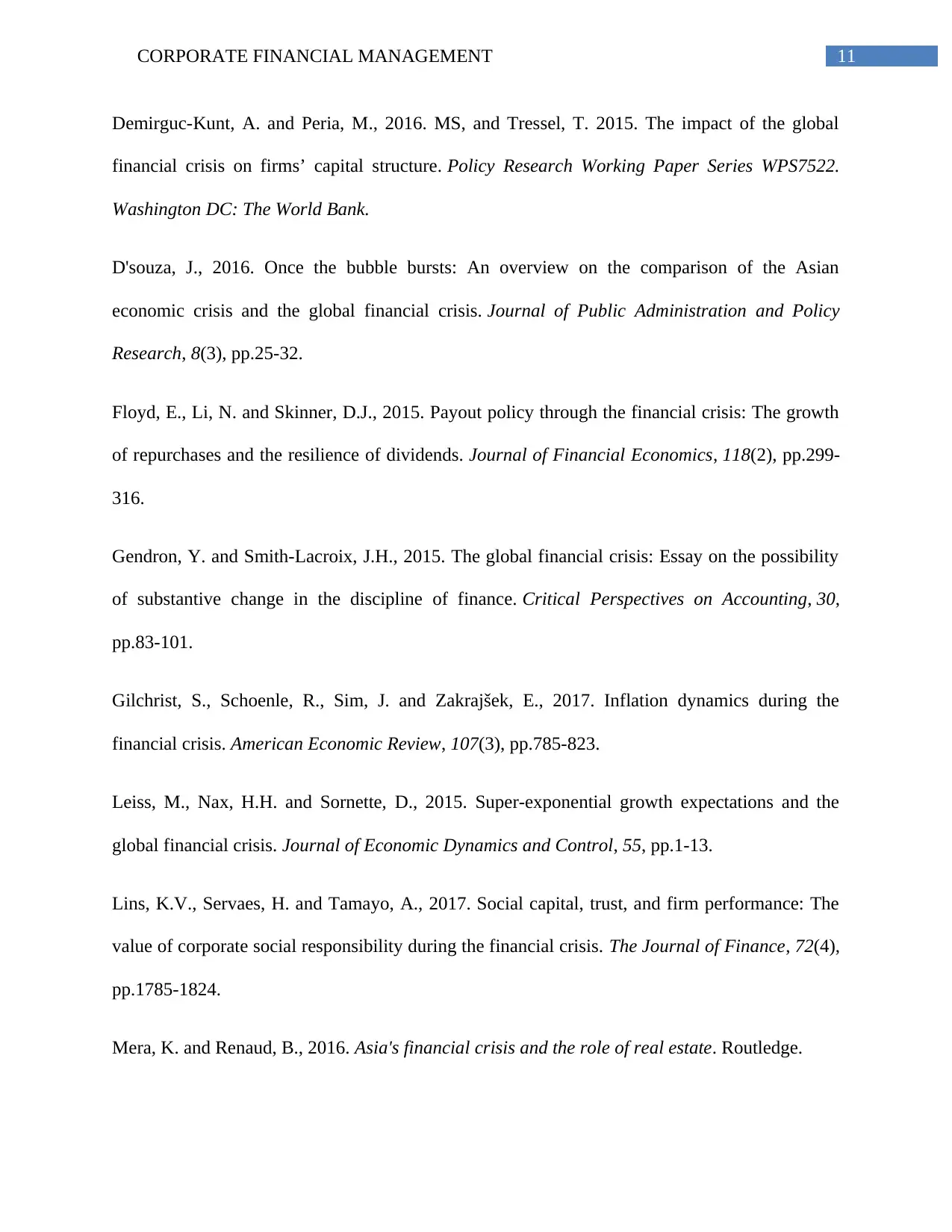
11CORPORATE FINANCIAL MANAGEMENT
Demirguc-Kunt, A. and Peria, M., 2016. MS, and Tressel, T. 2015. The impact of the global
financial crisis on firms’ capital structure. Policy Research Working Paper Series WPS7522.
Washington DC: The World Bank.
D'souza, J., 2016. Once the bubble bursts: An overview on the comparison of the Asian
economic crisis and the global financial crisis. Journal of Public Administration and Policy
Research, 8(3), pp.25-32.
Floyd, E., Li, N. and Skinner, D.J., 2015. Payout policy through the financial crisis: The growth
of repurchases and the resilience of dividends. Journal of Financial Economics, 118(2), pp.299-
316.
Gendron, Y. and Smith-Lacroix, J.H., 2015. The global financial crisis: Essay on the possibility
of substantive change in the discipline of finance. Critical Perspectives on Accounting, 30,
pp.83-101.
Gilchrist, S., Schoenle, R., Sim, J. and Zakrajšek, E., 2017. Inflation dynamics during the
financial crisis. American Economic Review, 107(3), pp.785-823.
Leiss, M., Nax, H.H. and Sornette, D., 2015. Super-exponential growth expectations and the
global financial crisis. Journal of Economic Dynamics and Control, 55, pp.1-13.
Lins, K.V., Servaes, H. and Tamayo, A., 2017. Social capital, trust, and firm performance: The
value of corporate social responsibility during the financial crisis. The Journal of Finance, 72(4),
pp.1785-1824.
Mera, K. and Renaud, B., 2016. Asia's financial crisis and the role of real estate. Routledge.
Demirguc-Kunt, A. and Peria, M., 2016. MS, and Tressel, T. 2015. The impact of the global
financial crisis on firms’ capital structure. Policy Research Working Paper Series WPS7522.
Washington DC: The World Bank.
D'souza, J., 2016. Once the bubble bursts: An overview on the comparison of the Asian
economic crisis and the global financial crisis. Journal of Public Administration and Policy
Research, 8(3), pp.25-32.
Floyd, E., Li, N. and Skinner, D.J., 2015. Payout policy through the financial crisis: The growth
of repurchases and the resilience of dividends. Journal of Financial Economics, 118(2), pp.299-
316.
Gendron, Y. and Smith-Lacroix, J.H., 2015. The global financial crisis: Essay on the possibility
of substantive change in the discipline of finance. Critical Perspectives on Accounting, 30,
pp.83-101.
Gilchrist, S., Schoenle, R., Sim, J. and Zakrajšek, E., 2017. Inflation dynamics during the
financial crisis. American Economic Review, 107(3), pp.785-823.
Leiss, M., Nax, H.H. and Sornette, D., 2015. Super-exponential growth expectations and the
global financial crisis. Journal of Economic Dynamics and Control, 55, pp.1-13.
Lins, K.V., Servaes, H. and Tamayo, A., 2017. Social capital, trust, and firm performance: The
value of corporate social responsibility during the financial crisis. The Journal of Finance, 72(4),
pp.1785-1824.
Mera, K. and Renaud, B., 2016. Asia's financial crisis and the role of real estate. Routledge.
⊘ This is a preview!⊘
Do you want full access?
Subscribe today to unlock all pages.

Trusted by 1+ million students worldwide
1 out of 13
Related Documents
Your All-in-One AI-Powered Toolkit for Academic Success.
+13062052269
info@desklib.com
Available 24*7 on WhatsApp / Email
![[object Object]](/_next/static/media/star-bottom.7253800d.svg)
Unlock your academic potential
Copyright © 2020–2025 A2Z Services. All Rights Reserved. Developed and managed by ZUCOL.





